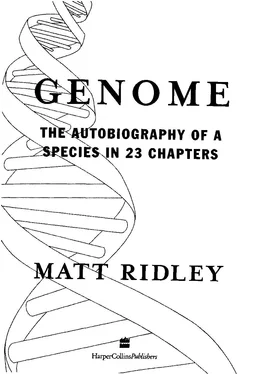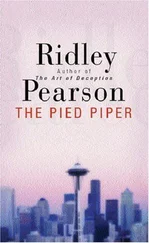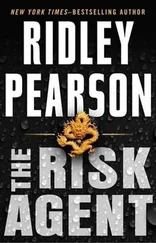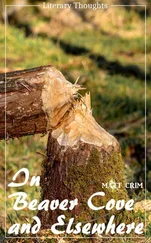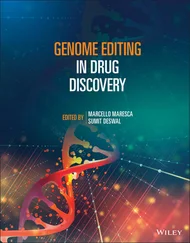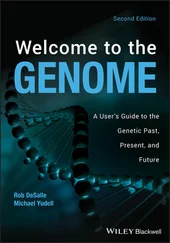Genome - Matt Ridley
Здесь есть возможность читать онлайн «Genome - Matt Ridley» — ознакомительный отрывок электронной книги совершенно бесплатно, а после прочтения отрывка купить полную версию. В некоторых случаях можно слушать аудио, скачать через торрент в формате fb2 и присутствует краткое содержание. Жанр: Старинная литература, на английском языке. Описание произведения, (предисловие) а так же отзывы посетителей доступны на портале библиотеки ЛибКат.
- Название:Matt Ridley
- Автор:
- Жанр:
- Год:неизвестен
- ISBN:нет данных
- Рейтинг книги:5 / 5. Голосов: 1
-
Избранное:Добавить в избранное
- Отзывы:
-
Ваша оценка:
- 100
- 1
- 2
- 3
- 4
- 5
Matt Ridley: краткое содержание, описание и аннотация
Предлагаем к чтению аннотацию, описание, краткое содержание или предисловие (зависит от того, что написал сам автор книги «Matt Ridley»). Если вы не нашли необходимую информацию о книге — напишите в комментариях, мы постараемся отыскать её.
Matt Ridley — читать онлайн ознакомительный отрывок
Ниже представлен текст книги, разбитый по страницам. Система сохранения места последней прочитанной страницы, позволяет с удобством читать онлайн бесплатно книгу «Matt Ridley», без необходимости каждый раз заново искать на чём Вы остановились. Поставьте закладку, и сможете в любой момент перейти на страницу, на которой закончили чтение.
Интервал:
Закладка:
By then, genetics was exploding with new ideas and Garrod had been dead for a decade.1
We now know that the main purpose of genes is to store the recipe for making proteins. It is proteins that do almost every chemical, structural and regulatory thing that is done in the body: they generate energy, fight infection, digest food, form hair, carry oxygen and so on and on. Every single protein in the body is made from a gene by a translation of the genetic code. The same is not quite true in reverse: there are genes, which are never translated into protein, such as the ribosomal-RNA gene of chromosome 1, but even that is involved in making other proteins. Garrod's conjecture is basically correct: what we inherit from our parents is a gigantic list of recipes for making proteins and for making protein-making machines - and little more.
Garrod's contemporaries may have missed his point, but at least they honoured him. The same could not be said of the man on whose shoulders he stood, Gregor Mendel. You could hardly imagine a H I S T O R Y 4 1
more different background from Garrod's than Mendel's. Christened Johann Mendel, he was born in the tiny village of Heinzendorf (now Hynoice) in Northern Moravia in 1822. His father, Anton, was a smallholder who paid his rent in work for his landlord; his health and livelihood were shattered by a falling tree when Johann was sixteen and doing well at the grammar school in Troppau. Anton sold the farm to his son-in-law so he could afford the fees for his son at school and then at university in Olmiitz. But it was a struggle and Johann needed a wealthier sponsor, so he became an Augustinian friar, taking the name Brother Gregor. He trundled through theological college in Brunn (now Brno) and emerged a priest. He did a stint as a parish priest, but it was not a success. He tried to become a science teacher after studying at Vienna University, but failed the examination.
Back to Brunn he went, a thirty-one-year-old nonentity, fit only for monastic life. He was good at mathematics and chess playing, had a decent head for figures and possessed a cheerful disposition.
He was also a passionate gardener, having learnt from his father how to graft and breed fruit trees. It is here, in the folk knowledge of the peasant culture, that the roots of his insight truly lay. The rudiments of particulate inheritance were dimly understood already by the breeders of cattle and apples, but nobody was being systematic. 'Not one [experiment]', wrote Mendel, 'has been carried out to such an extent and in such a way as to make it possible to determine the number of different forms with certainty according to their separate generations, or definitely to ascertain their statistical relations.' You can hear the audience dozing off already.
So Father Mendel, aged thirty-four, started a series of experiments on peas in the monastery gardens that were to last eight years, involve the planting of over 30,000 different plants - 6,000 in 1860
alone - and eventually change the world forever. Afterwards, he knew what he had done, and published it clearly in the proceedings of the Brunn society for the study of natural science, a journal that found its way to all the best libraries. But recognition never came and Mendel gradually lost interest in the gardens as he rose to 4 2 G E N O M E
become the abbot of Brunn, a kindly, busy and maybe not very pious friar (good food gets more mention in his writing than God).
His last years were taken up with an increasingly bitter and lonely campaign against a new tax levied on monasteries by the government, Mendel being the last abbot to pay it. Perhaps his greatest claim to fame, he might have reflected in old age, was that he made Leos Janacek, a talented nineteen-year-old boy in the choir school, the choirmaster of Brunn.
In the garden, Mendel had been hybridising: crossing different varieties of pea plant. But this was no amateur gardener playing at science; this was a massive, systematic and carefully thought-out experiment. Mendel chose seven pairs of varieties of peas to cross.
He crossed round-seeded peas with wrinkled ones; yellow cotyledons with green ones; inflated seed pods with wrinkled seed pods; grey seed coats with white seed coats; green unripe pods with yellow unripe pods; axial flowers with terminal flowers; tall stems with dwarf stems. How many more he tried we do not know; all of these not only breed true, but are due to single genes so he must have chosen them knowing already from preliminary work what result to expect. In every case, the resulting hybrids were always like just one parent. The other parent's essence seemed to have vanished. But it had not: Mendel allowed the hybrids to self-fertilise and the essence of the missing grandparent reappeared intact in roughly one-quarter of the cases. He counted and counted - 19,959 plants in the second generation, with the dominant characters outnumbering the reces¬
sives by 14,949 to 5,010, or 2.98 to 1. It was, as Sir Ronald Fisher pointed out in the next century, too suspiciously close to a ratio of three. Mendel, remember, was good at mathematics and he knew well before the experiments were over what equation his peas were obeying.2
Like a man possessed, Mendel turned from peas to fuschias, maize and other plants. He found the same results. He knew that he had discovered something profound about heredity: characteristics do not mix. There is something hard, indivisible, quantum and particulate at the heart of inheritance. There is no mingling of fluids, no blending of blood; there is instead a temporary joining together of H I S T O R Y 4 3
lots of little marbles. In retrospect, this was obvious all along. How else could people account for the fact that a family might contain a child with blue eyes and a child with brown? Darwin, who none the less based his theory on blending inheritance, hinted at the problem several times. 'I have lately been inclined to speculate', he wrote to Huxley in 1857, 'very crudely and indistinctly, that propagation by true fertilisation will turn out to be a sort of mixture, and not true fusion, of two distinct individuals . . . I can understand on no other view the way in which crossed forms go back to so large an extent to ancestral forms.'3
Darwin was not a little nervous on the subject. He had recently come under attack from a fierce Scottish professor of engineering, strangely named Fleeming Jenkin, who had pointed out the simple and unassailable fact that natural selection and blending inheritance did not mix. If heredity consisted of blended fluids, then Darwin's theory probably would not work, because each new and advantageous change would be lost in the general dilution of descent. Jenkin illustrated his point with the story of a white man attempting to convert an island of black people to whiteness merely by breeding with them. His white blood would soon be diluted to insignificance.
In his heart Darwin knew Jenkin was right, and even the usually ferocious Thomas Henry Huxley was silenced by Jenkin's argument, but Darwin also knew that his own theory was right. He could not square the two. If only he had read Mendel.
Many things are obvious in retrospect, but still take a flash of genius to become plain. Mendel's achievement was to reveal that the only reason most inheritance seems to be a blend is because it involves more than one particle. In the early nineteenth century John Dalton had proved that water was actually made up of billions of hard, irreducible little things called atoms and had defeated the rival continuity theorists. So now Mendel had proved the atomic theory of biology. The atoms of biology might have been called all sorts of things: among the names used in the first years of this century were factor, gemmule, plastidule, pangene, biophor, id and idant. But it was 'gene' that stuck.
Читать дальшеИнтервал:
Закладка:
Похожие книги на «Matt Ridley»
Представляем Вашему вниманию похожие книги на «Matt Ridley» списком для выбора. Мы отобрали схожую по названию и смыслу литературу в надежде предоставить читателям больше вариантов отыскать новые, интересные, ещё непрочитанные произведения.
Обсуждение, отзывы о книге «Matt Ridley» и просто собственные мнения читателей. Оставьте ваши комментарии, напишите, что Вы думаете о произведении, его смысле или главных героях. Укажите что конкретно понравилось, а что нет, и почему Вы так считаете.
